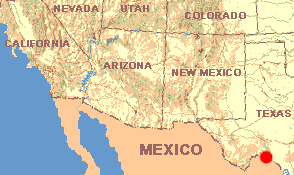 January 15, 1988
January 15, 1988TEXAS: Valverde County
US 377 North Campground in Amistad National Recreation Area 7 miles north of Del Rio
 January 15, 1988
January 15, 1988Days and nights at Amistad pass calmly and pleasantly, with Sundays and Thursdays being little different from Tuesdays and Fridays. Each morning after the campfire ritual I take a long walk, usually accompanied by Bird-Bill. Dog-Bill's hysterical pit bulls, very slow pace and tendency to sleep late keep him from being invited along. Bird-Bill and I return from our walks carrying deer skulls with antlers attached, rocks adorned with crystals and fossils, and lists of birds and cacti.
In the afternoons I wander alone, or for hours just sit watching the coots on the lake. Slowly I recover from the excesses of Christmas in Kentucky. Though I treasure my family, I have many issues with the consumption-oriented underpinnings of my culture. Leaving right after Christmas and coming into the desert was like walking out of a tedious Italian opera buffa into an elegant, crystalline Bach fugue.
As in a fugue, the desert-understandings coming to me from this edge-of-the-desert are understated and often cryptic. In order to show you one way in which I am communicating with the desert, let me describe today's experience with a sun-bleached skull found half embedded in gully mud not far from camp.I didn't know from what kind of animal the skull had come so from the little library in Henry I pulled out one of the Peterson Field Guide Series, A Field Guide to the Mammals : North America North of Mexico, by Burt and Grossenheider.
Now, the number of teeth in a mammal's skull varies from species to species, but all the individuals within a species generally bear the same number. Thus domesticated dogs possess forty-two teeth while domesticated cats have thirty. These teeth are arranged in particular ways, with every tooth belonging in one of the following categories:
Moreover, the distribution of an animal's kinds of teeth can be described schematically with "dental formulas." In the back of my mammal book dental formulas are explained and formulas for many mammal species are given. After reviewing the formulas' formats, I figured out the gully-mud skull's dental formula as the following:
| incisors | canines | premolars | molars | total | |
| UPPER | 3-3 | 1-1 | 3-3 | 1-1 | 16 |
| LOWER | 3-3 | 1-1 | 2-2 | 1-1 | 14 |
In the above formula the first number 3-3 means that in the upper jaw's left side three incisors are found, and three are on the right. The next number, 1-1, means that one canine is on the right in the upper jaw, and one is on the left. The formula goes on to show that the skull has sixteen teeth in the upper jaw and fourteen in the lower, for a grand total of thirty teeth in the whole skull.
The gully-mud skull's entire formula wasn't immediately obvious. While the skull's incisors and canines were easy to identify (incisors bite and are up front, while canines stab and are right behind the incisors), I couldn't decide where the premolars ended and the molars began.
Nonetheless, the teeth could be counted. The gully-mud skull had thirty teeth, with sixteen in the upper jaw and fourteen in the lower. Referring to the field guide's chart I found only two genera with that precise configuration of teeth -- the genus Leptonycteris (the longnose bat) and the genus Felis (cats). Since Leptonycteris possesses eight incisors while Felis bears twelve and the gully-mud skull had twelve incisors, just using part of the dental formulas, I figured out that the gully-mud skull belonged to some kind of cat. So, what kind of cat was it?
Also in the back of the mammal field guide are photographs of a selection of mammal skulls. The only Felis skull pictured is the mountain lion. The gully-mud skull is shaped very much like the mountain lion's but it's much smaller. According to the field guide's species-distribution maps, the following species of the genus Felis may be found at Amistad:
.The book doesn't mention it, but everyone knows that the domestic cat also is a member of the genus Felis, and they're found here, too. In fact, Bird-Bill says that sometimes people from Del Rio "drop" their unwanted cats at this campground so that often a real cat-problem develops. In short, my gully-mud skull may belong to a margay or one of those other rare cats but I suspect it's just a housecat's skull.
The process just described might seem a bit monotonous. The pleasure the process brings can only be understood in terms of its being a meditation that calms and focuses in a healing, nurturing way...